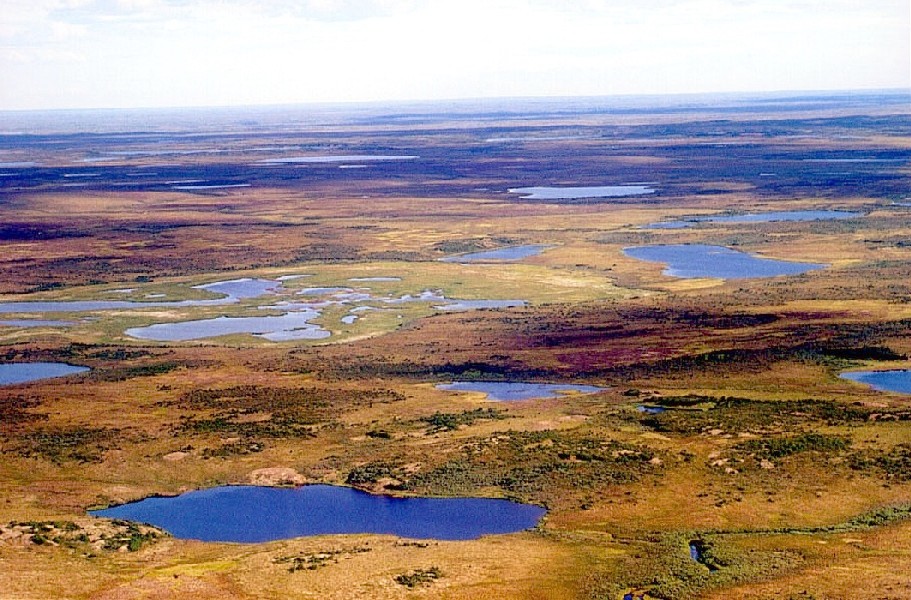|
Slettnes Nature Reserve
The Slettnes Nature Reserve is a 1158 ha protected area of land in Gamvik Municipality in Finnmark county, Norway. It borders the Arctic Barents Sea near the village of Gamvik on the northern coast of the Nordkinn Peninsula. The Slettnes Lighthouse lies within the reserve. Environment The reserve largely coincides with the 1230 ha Slettnes Ramsar site and the terrestrial component of the Slettnes Important Bird Area (IBA), designated as such by BirdLife International because it supports several bird species while they are breeding, overwintering or passing through on migration. Habitats in the IBA include fens, mires, springs and raised bogs, as well as tundra, the coast and neritic waters. The birds for which the IBA was designated include long-tailed ducks, common eiders, Steller's eiders, common scoters, yellow-billed loons, ruddy turnstones, Temminck's stints, little stints, red-necked phalaropes, black-legged kittiwakes, Arctic jaegers, pomarine jaegers, razorbil ... [...More Info...] [...Related Items...] OR: [Wikipedia] [Google] [Baidu] |
Tundra
In physical geography, a tundra () is a type of biome where tree growth is hindered by frigid temperatures and short growing seasons. There are three regions and associated types of tundra: #Arctic, Arctic, Alpine tundra, Alpine, and #Antarctic, Antarctic. Tundra vegetation is composed of dwarf shrubs, Cyperaceae, sedges, Poaceae, grasses, mosses, and lichens. Scattered trees grow in some tundra regions. The ecotone (or ecological boundary region) between the tundra and the forest is known as the tree line or timberline. The tundra soil is rich in nitrogen and phosphorus. The soil also contains large amounts of biomass and decomposed biomass that has been stored as methane and carbon dioxide in the permafrost, making the tundra soil a carbon sink. As global warming heats the ecosystem and causes soil thawing, the permafrost carbon cycle accelerates and releases much of these soil-contained greenhouse gases into the atmosphere, creating Climate change feedback, a feedback cycle t ... [...More Info...] [...Related Items...] OR: [Wikipedia] [Google] [Baidu] |
Pomarine Jaeger
The pomarine jaeger (''Stercorarius pomarinus''), pomarine skua, or pomatorhine skua, is a seabird in the skua family Stercorariidae. It is a migrant, wintering at sea in the tropical oceans. Taxonomy The Pomarine Jaeger is most closely related to the larger skuas (species formerly placed in a separate genus ''Catharacta'': Great Skua, Chilean Skua, Brown Skua, and South Polar Skua). Together, the Pomarine Jaeger and the larger skuas are sister to the two smaller skua species, the Parasitic Jaeger and Long-tailed Jaeger. The evolutionary relationships of the Pomarine Jaeger were formerly controversial. Based on plumage similarity between the Pomarine Jaeger and the two smaller jaegers ( Long-tailed Jaeger and Parasitic Jaeger), the three jaegers were formerly placed in a separate genus from the larger skuas (with the jaegers in '' Stercorarius'' and the larger skuas in the former genus ''Catharacta''). However, behavioural evidence was recognized early on as suggesting a l ... [...More Info...] [...Related Items...] OR: [Wikipedia] [Google] [Baidu] |
Arctic Jaeger
The parasitic jaeger (North America) or Arctic skua (Europe) (''Stercorarius parasiticus''), is a seabird in the skua family Stercorariidae. It is a migratory species breeding in Northern Scandinavia, Scotland, Iceland, Greenland, Northern Canada, Alaska, and Siberia and winters across the southern hemisphere. Kleptoparasitism is a major source of food for this species during migration and winter, and is where the name is derived from. Taxonomy The parasitic jaeger was formally described in 1758 by the Swedish naturalist Carl Linnaeus in the tenth edition of his ''Systema Naturae'' under the binomial name ''Larus parasiticus''. Linnaeus specified the type locality as "within the Tropic of Cancer of Europe, America and Asia" but this is now restricted to the Swedish coastline. The parasitic jaeger is now placed with the six other skuas in the genus '' Stercorarius'' that was introduced in 1760 by the French zoologist Mathurin Jacques Brisson. The species is considered to be monot ... [...More Info...] [...Related Items...] OR: [Wikipedia] [Google] [Baidu] |



